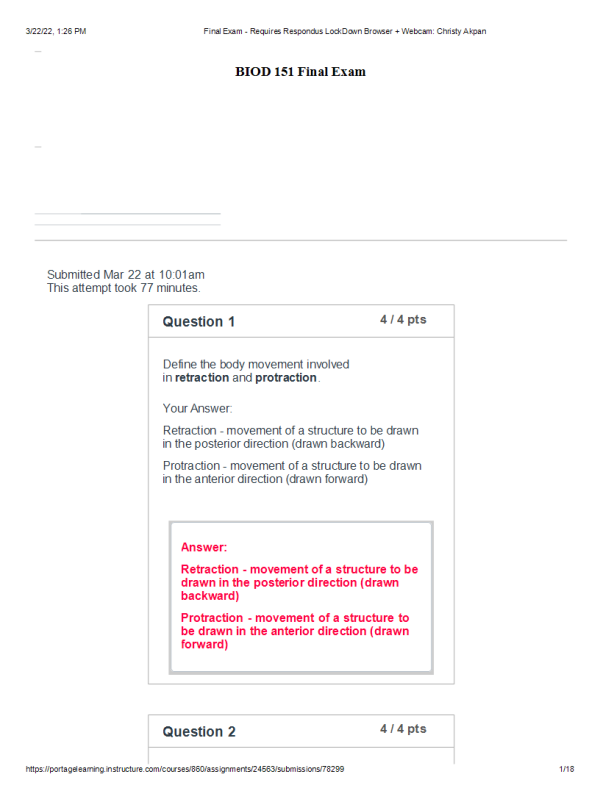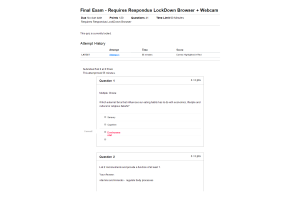BIOD 151 Final Exam
Course : BIOS 151 Essential Human Anatomy & Physiology I with Lab
Contributed : Egreta Ston
- $40.00
- Question: Define the body movement involved in retraction and protraction.
- Question: Name the anatomical pair of terms that best describe the directions of the red arrows in the figure below. (Note that two responses are needed for full credit).
- Question: Determine whether each of the following statements is true or false.
- Question: Name the planes of the body shown in Figures A and B below.
- Question: Each of the following statements is true of prokaryotic cells, except:
- Question: True or False; if false, make the statement true: Endoplasmic reticulum contains DNA and serves as the control center of the cell.
- Question: Name the two structures (A and B) found inside the cell below.
- Question: Which of the following is NOT true concerning a cell wall?
- Question: Fill in the blank: ______ is the diffusion of relatively larger lipid insoluble (polar) molecules through the cell membrane with the assistance of integral carrier proteins.
- Question: Match each term with the correct definition concerning water solutions in cells.
- Question: Are the following statements true or false concerning the sodium-potassium pump in cell membranes?
- Question: True or False: The left lung has 2 lobes.
- Question: True or False: The hilum is where the pulmonary vessels and bronchi enter through each lung.
- Question: Which of the following structures does the tongue attach to?
- Question: True or False: The mouth is made up of the following structures: The lips form the opening; the tongue forms the floor; the cheeks form the walls; the hard and soft palates form the roof; and the uvula forms the posterior border.
- Question: True or False: Sesamoid bones are small and round, reinforcing tendons.
- Question: True or False: A foramen is a hollow chamber in bone, usually filled with air.
- Question: True or False: Peripheral nerves carry signals from the central nervous system to a specific muscle destination to provide movement.
- Question: Which of the following structures are connective tissue that connect bone to bone to stabilize joints where bones meet?
- Question: True or False: Secondary endocrine organs include the hypothalamus, pituitary gland, pineal gland, thyroid gland, parathyroid glands, adrenal glands, and pancreas.
- Question: Fill in the blank: The skin is made up of the ________ (outer layer), _________ (middle layer), and the __________ (inner, also called subcutaneous tissue layer).
- Question: True or False: Gas exchange takes place by the physical process of diffusion. For diffusion to be effective, the gas-exchange region must be (1) moist, (2) thick, and (3) small in relation to the size of the body.
- Question: True or False: During exhalation, the rib cage is lowered, the diaphragm rises, the thoracic pressure increases, and air will naturally move out of the lungs where the pressure is lower.
- Question: Cholecystokinin causes the liver to secrete bile.
- Question: This process helps to create a proton motive force:
- Question: Which of the following is a unique feature of spongy bone?
- Question: Which of the following joint articulations is a cartilaginous joint?
- Question: Discuss which type of muscle tissue can be found in the digestive tract and if it can be controlled voluntarily. Describe what it looks like if you were to study it under a microscope.
- Question: The purpose of the Z line is to:
- Question: This hormone is released from the anterior pituitary and causes the mammary glands in the breasts to develop.
- Question: Discuss the purpose of mast cells in the tissue repair process. (Include at least two supporting points in your response.) Mast cells release chemicals that promotes the inflammation response of the body. Mast cells also realease chemical such as histamine
- Question: Patients with this respiratory disease have sharp chest pain that worsens with breathing.
- Question: This disease process causes synovial joints to become thick and inflamed:
- Question: Following a motor vehicle accident (MVA), your patient has an area of skin that was exposed to fire. The skin appears white and has an area where muscle tissue was damaged. 1) What type of burn would best describe this injury? 2) What layers of the skin are damaged?
- Question: This condition is caused by an overproduction of growth hormone as a child.


